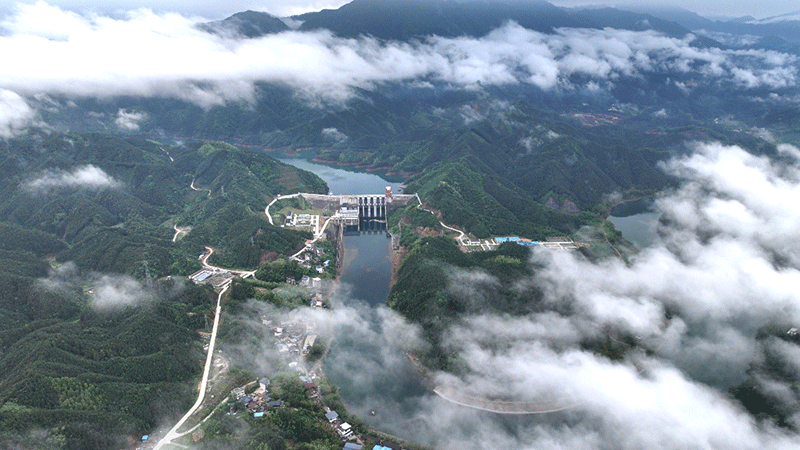 |
| An overview of a water conservancy facility in South China’s Guangxi Zhuang Autonomous Region. |
Prolonged drought affects 405,000 people in S.China’s Guangxi, causes US$28.8 mln of economic losses
(Global Times) -- Facing the lowest precipitation level since 1961 and with nearly 98 percent of its area affected by prolonged drought, South China’s Guangxi Zhuang Autonomous Region has seen 405,000 people impacted, with direct economic losses reaching 210 million yuan (US$28.8 million). Local authorities have allocated 17.5 million yuan (US$2.4 million) in drought relief to support affected communities.
Statistics from the emergency management department of Guangxi show that as of 9 am on Monday, a prolonged dry period has occurred in 52 counties in 11 cities, leaving 405,000 people, including 83,000 facing drinking water shortages, according to the Guangxi Emergency Management Department, China Central Television (CCTV) reported.
In addition, 51,000 hectares of crops were affected by the drought, with 16,200 hectares severely damaged.
The department of water resources activated a Level III emergency response to fight drought on Saturday and sent work groups to drought-affected cities including Nanning, Qinzhou, Guigang, Laibin and Chongzuo to provide on-site guidance to ensure supply of safe drinking water and irrigation water.
The water conservancy department of Guangxi has deployed water resources scientifically, carried out in-depth construction of small-scale agricultural water conservancy facilities, added and restored 1,526.67 hectares of irrigated area and improved the irrigated area by 18,460 hectares.
The region’s emergency management department has coordinated with water resources and fire rescue agencies to deliver emergency water supplies. Using fire trucks and through vehicle-loaded bottled drinking water, a total of 3,476 tons of water has been delivered by the fire department in emergency.
Besides, the department of finance of Guangxi has allocated 17.5 million yuan in drought relief to support 36 counties and districts in eight cities, in implementing local drought mitigation efforts, CCTV reported.
The severe drought was caused by significantly lower precipitation compared to previous years, which is unusual for the current rain season in this region, Ma Jun, director of the Beijing-based Institute of Public and Environmental Affairs, told the Global Times on Monday, noting that the severe drought would exert impact on water supply to the cities and the drinking water supply to local people as well as livestock.
According to the flood control and drought relief headquarters in Guangxi, the region is currently facing a severe drought, with 97.5 percent of the total area, including 68.7 percent suffering from a severe drought, the monitoring statistics on April 17 showed.
The drought is more severe than in previous years, impacting drinking water for both people and livestock, and affecting agricultural production. There exist higher risks of forest fires and urban water shortages in some counties.
Rainfalls are expected to be concentrated in the northeastern Guangxi before the end of April, while other drought-stricken areas may see minimal precipitation, worsening drought conditions, experts said.
Natural inflows for most rivers in Guangxi are currently 30 to 50 percent lower than average for the same period in previous years.
According to the Guangxi meteorological bureau, since November 2024, the average precipitation in Guangxi is estimated at 110.0 millimetres, nearly 70 percent less than the average for the same period in previous years, a record low for this period since 1961.
According to the water resource authorities, since March 11, river water inflows across Guangxi have been approximately 20 percent lower than the historical average for the same period. On April 11, the total water storage of 21 large reservoirs primarily used for irrigation in Guangxi amounted to 2.12 billion cubic metres, about 30 percent less than the average for the same period in previous years and nearly 30 percent less than the same period last year.
Meanwhile, the local hydrology authority in Guangxi observed the rainfalls in part areas of the region including Hezhou, Hechi, Wuzhou, Baise and Guilin between 8 am on Sunday and 8 am on Monday, with rainstorms occurred in some areas. Due to the downpour, the Xihe River, a tributary of the Luoqing River, experienced flooding that exceeded the warning level by 0.37 metres at 10:50 am on Sunday, marking the first above-warning-level flood in Guangxi this year.
Reports indicate that drought conditions have been partially alleviated in parts of Guilin, Liuzhou, Hezhou, Baise and Hechi.
(Latest Update April 23, 2025)
|